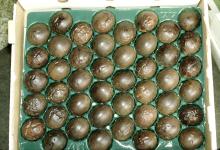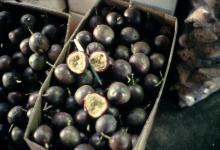Índices de madurez
The amount of yellow or purple color on the fruit surface is used as a maturity index for fresh market passion fruits. In some cases fruits are allowed to fall and are collected from the ground for processing into juice concentrate, jam, and other products.
- The fruit is a berry 3.5 to 7 cm wide and 4 to 12 cm long and has a moderately hard shell (3-10 mm thick), depending on cultivar
- The edible portion is the fleshy, acidic pericarp together with the arils surrounding the seeds
- Fruit color may be purple or yellow
- Soluble solids content ranges between 14 and 18% and acidity ranges from 3 to 5% in the pulp
- Moisture loss during ripening may be large enough to cause shriveling of passion fruits, but this does not influence the edible portion
Manejo y almacenamiento poscosecha
7-10°C (45-50°F) for partially-ripe fruits (potential storage life = 3-5 weeks) 5-7°C (41-45°F) for fully-ripe fruits (potential storage life = 1 week)
| Temperature | 5°C (41°F) | 10°C (50°F) | 20°C (68°F) |
|---|---|---|---|
| ml CO2/kg·hr | 15-30 | 20-40 | 45-100 |
To calculate heat production multiply ml CO2/kg·hr by 440 to get Btu/ton/day or by 122 to get kcal/metric ton/day.
Exposure of mature-green passion fruits to 100 ppm ethylene for 1-2 days accelerates their ripening. Once ripening begins exogenous ethylene treatment is unnecessary because the fruits produce high ethylene concentrations.
90-95%
Passion fruits are the highest ethylene producers among all fruits with a production range of 160-370 µl/kg·hr at 20°C (68°F) at their climacteric peak.
No published information available.
Passion fruits may benefit from packaging in perforated plastic films (no or minor effect on atmospheric modification) due to reduction in water loss during handling.
Desórdenes
Chilling injury. Symptoms occur on passion fruits kept at 5°C (41°F) or lower and include surface and internal discoloration, pitting, water-soaked areas, uneven ripening or failure to ripen, off-flavor development, and increased decay incidence.
Brown spot. Caused by Alternaria passiflorae and appears as circular, sunken, light-brown spots on ripening fruits. Disease incidence is most severe during warm wet periods.
Phytophthora fruit rot. Caused by Phytophthora nicotianae var. parasitica and appears as water-soaked, dark-green patches which dry up.
Septoria spot. Caused by Septoria passiflorae which infects fruits while on the plant and results in uneven ripening.
Control Procedures
Effective vineyard sanitation, pruning and leaf thinning to allow more air and light to reach the canopy, application of preharvest fungicides, and proper management of temperature and relative humidity during postharvest handling.


